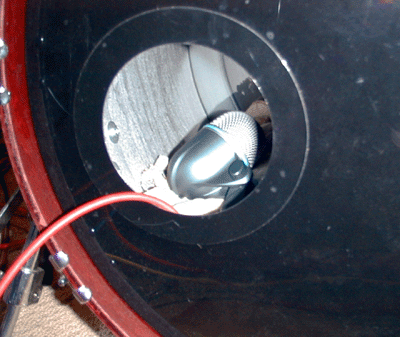The kick or bass drum is easy to record since it is usually played (in pop music) at the same volume throughout the song. Producers and engineers look for a "marriage" of the bass drum with the bass instrument because they both occupy and make up the important bottom end of the record. Fig. 3 shows my usual starting place for the bass drum mic. The Beta 52 in the picture is placed half in and half out of the hole in the front head. This distance is variable and I try to keep the mic pointed exactly at the spot on the rear head where the beater hits. Fig. 4 shows an old '70s' trick where the microphone goes right inside the drum. This produces a very present and dry sound that was great for disco music before the Linn drum machine. You should put a weight (sand bags are good) to hold the mic in place inside the drum.
 |
| Fig. 3 Typical Bass Drum Microphone Placement |
Some engineers like to place a second mic further out in front the kick drum to get a more ambient bass drum sound. I have used a PZM (pressure zone microphone) for this and just loved the sound. Mixing the two mics is touchy business and I recommend using a separate track for this mic. You will also get a lot of spill from the rest of the kit that could wash out the total drum sound if this mic is monitored loudly. Another mic position I have used is a second mic aimed at where the beater hits the rear head. This mic is place next to the kick drum pedal. You'll get completely different bass drum sound that might work great for your song but don't expect too much low end from this mic.
Microphone Choice
 |
| Fig. 4 Alternative Kick Drum Microphone Placement |
I like the Shure Beta 52, the AKG D-12 or D-112, and the Sennheiser MD-421U. I am little reluctant to use a condenser or ribbon mic on the kick drum since a lot of air pumps straight out into the mic. This air blast can dislodge a ribbon or damage the capsule of a condenser. There is also a high Sound Pressure Level (SPL) present that can overload and distort; besides I have other better uses for condensers during a drum session. If you want to try a condenser on the kick, try the new Sennheiser e865 hand-held that will take 150dB SPL.
One good trick is to use a compressor when recording the bass drum. I don't want a "compressed" sound here so gain reduction is almost zero...one to two dB max. I am looking for the added low end the compressor will bring up...it is different from just equalizing in low frequencies. Added low frequencies never sounds very good to me...sounding more like the equalizer than true bottom. You can help a drummer who has an uneven bass drum level with a compressor, but you have to commit to a super heavy squash to fix this problem. Starting out compressor settings would be a medium attack time and a 3:1 ratio.
Other Goodies For Getting Great Drum Sounds
Sennheiser Evolution Series Of Drum Mics
Shure's KSM44 Condenser Mic
Audix i5 Dynamic Mic
Audix Micro-D Series Drum Mic
HQ SoundOff Bass Drum Mute
Shure's KSM32 Condenser Mic
AKG C451B Reissue Condenser Mic
Monster Cable's Turbine Pro In-Ear Speakers
UKKO Contact Drum Mics By B-Band
Heil Microphones' PR 48 Kick Drum Mic
Heil's PR 20 UT Dynamic Mic
Audio-Technica' KP-Drum Mic KitPak
Granelli G5790 Right-Angle SM57 Mic
Kelly Shu Kick Drum Mic Isolation/Mount